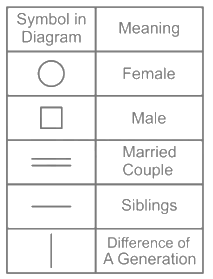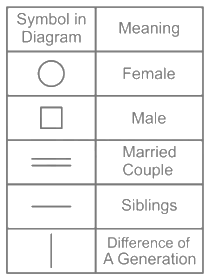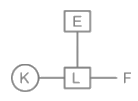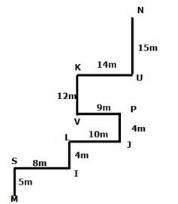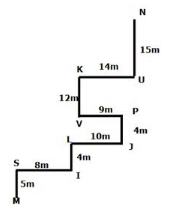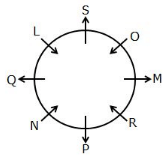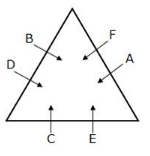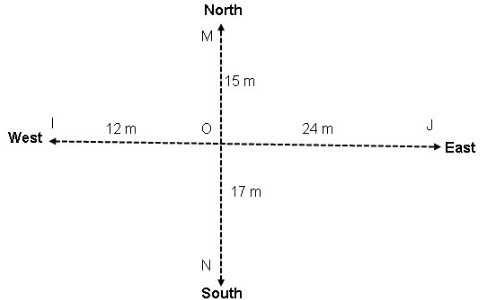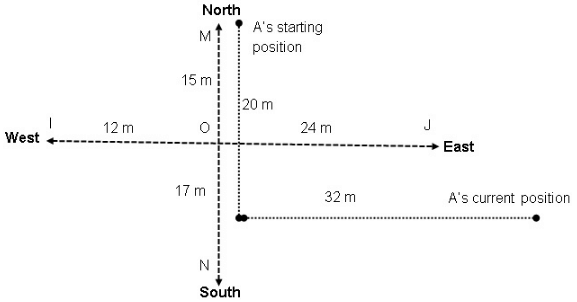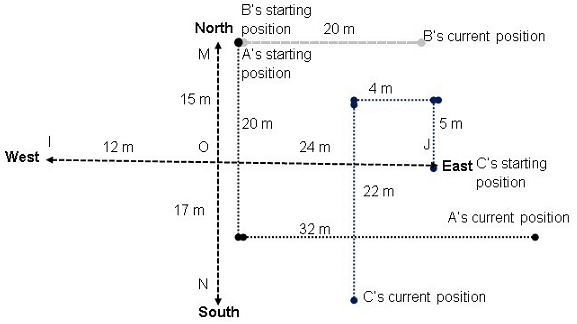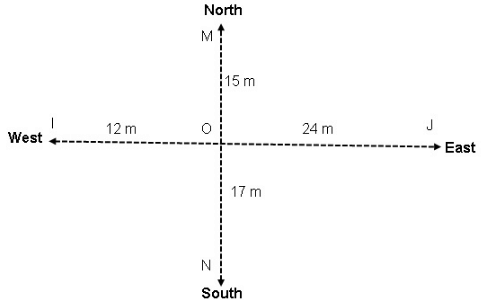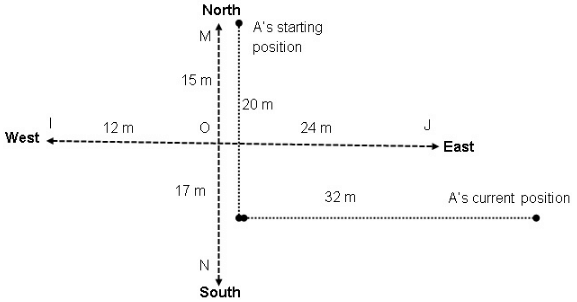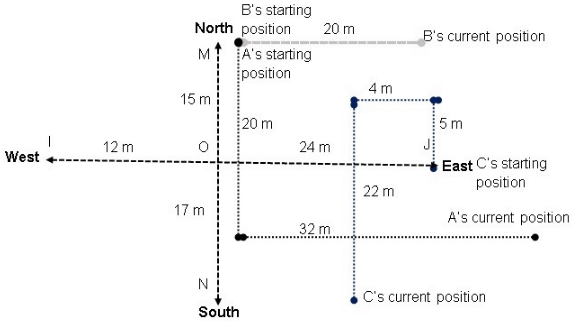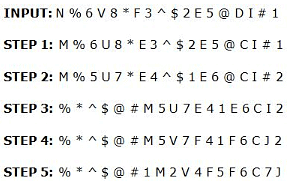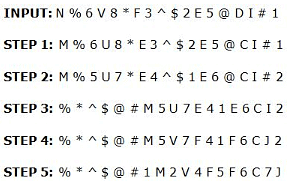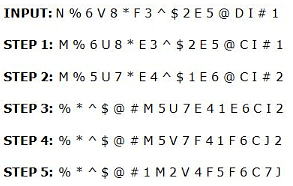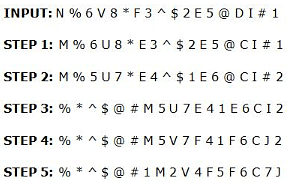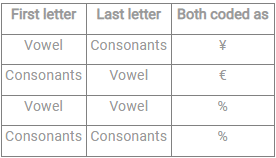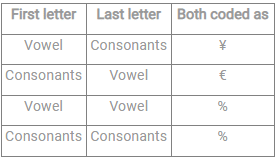IBPS RRB Clerk Mains Mock Test - 4 - Bank Exams MCQ
30 Questions MCQ Test - IBPS RRB Clerk Mains Mock Test - 4
The following series is framed sequentially. Follow the sequence and fill the remaining.
AKJR8472#&*!KJR472&*!JR72*!R ___
Study the following information carefully and answer the questions given below.
There are two rows given. To find out the resultant of a particular row, we need to follow the conditions given below.
Condition 1: If an odd number is followed by an even number, then the second number is subtracted from the first number.
Condition 2: If an odd number is followed by another odd number, then both the numbers are to be added.
Condition 3: If an even number is followed by another even number, then the second number is the resultant number.
Condition 4: If an even number is followed by an odd number, then both the numbers are to be multiplied.
Note: If the final resultant number of a row is an even number, then it should be divided by 2 else, If the final resultant number of a row is an odd number, then subtract 1 from the resultant number.
Q. If x is the resultant of the second row, then find the resultant of the first row?
Row 1: 45 16 x
Row 2: 32 55 14
Study the following information carefully and answer the questions given below.
There are two rows given. To find out the resultant of a particular row, we need to follow the conditions given below.
Condition 1: If an odd number is followed by an even number, then the second number is subtracted from the first number.
Condition 2: If an odd number is followed by another odd number, then both the numbers are to be added.
Condition 3: If an even number is followed by another even number, then the second number is the resultant number.
Condition 4: If an even number is followed by an odd number, then both the numbers are to be multiplied.
Note: If the final resultant number of a row is an even number, then it should be divided by 2 else, If the final resultant number of a row is an odd number, then subtract 1 from the resultant number.
Q. Find the resultant of the second row, where Y is the resultant of row 1.
Row 1: 49 18 33
Row 2: 26 Y 57
Study the following information carefully and answer the questions given below.
There are two rows given. To find out the resultant of a particular row, we need to follow the conditions given below.
Condition 1: If an odd number is followed by an even number, then the second number is subtracted from the first number.
Condition 2: If an odd number is followed by another odd number, then both the numbers are to be added.
Condition 3: If an even number is followed by another even number, then the second number is the resultant number.
Condition 4: If an even number is followed by an odd number, then both the numbers are to be multiplied.
Note: If the final resultant number of a row is an even number, then it should be divided by 2 else, If the final resultant number of a row is an odd number, then subtract 1 from the resultant number.
Q. Find the difference of the resultant of row2 from row1.
Row 1: 56 17 34
Row 2: 45 71 23
If it is possible to make only one six-letter meaningful English word with the 1st, 4th, and 8th letter of the word DEUTSCHMARK and 2nd, 3rdand 6th letter of the word MANEUVER, which of the following will be the second letter from the left of that word? If no such word can be made give ‘X’ as the answer and if more than one such word can be made give ‘Y’ as the answer.
Direction: Study the following information carefully to answer the given questions.
M@N means M is the wife of N
M#N means M is the son of N
M%N means M is the Sister of N
M$N means M is the father of N
Q. Which of the following expression shows I as the brother of H?
Direction: Study the following information carefully to answer the given questions.
M@N means M is the wife of N
M#N means M is the son of N
M%N means M is the Sister of N
M$N means M is the father of N
Q. In the expression “K%L#E$F” how is L related to F?
Study the following information carefully and answer the questions given below.
Mr. P walks from Point N towards the south direction for 15m to reach point U where he turns right and walks 14m to reach point K, where he turns left and walks 12m to reach point V, then he turns towards east and walks 9m to reach Point P.
Mr. Q walks from Point M towards the north direction for 5m to reach point S where he turns right and walks 8m to reach point I where he turns left and walks 4m to reach point L where he turns right and walks 10m to reach point J, which is 4m south of Point P.
Q. If point Z is to the east of point M and south of point U, then what is the distance between point N and point Z?
Study the following information carefully and answer the questions given below.
Mr. P walks from Point N towards the south direction for 15m to reach point U where he turns right and walks 14m to reach point K, where he turns left and walks 12m to reach point V, then he turns towards east and walks 9m to reach Point P.
Mr. Q walks from Point M towards the north direction for 5m to reach point S where he turns right and walks 8m to reach point I where he turns left and walks 4m to reach point L where he turns right and walks 10m to reach point J, which is 4m south of Point P.
Q. Four of the following five are alike in a certain way as per the given arrangement and hence form a group. Find the one that doesn't belong to that group.
Study the following information carefully and answer the questions given below.
Q. Eight persons - L, M, N, O, P, Q, R and S are sitting around a circular table such that the alternate persons face inside and outside, but not necessarily in the same order. Who among the person sits second to the right of R?
Statement I: N sits facing towards O, who sits second to the left of L. Q sits adjacent to L but not O. P sits immediate left of R, who is not adjacent to N. S is not adjacent to R.
Statement II: Both R and L face towards each other, where O sits adjacent to L. O is the immediate neighbour of S, who sits three persons away from P. R sits immediate right of M.
Study the following information carefully and answer the questions given below.
Q. Six persons - U, V, W, X, Y and Z are working on six different days of the same week from Monday to Saturday, but not necessarily in the same order. Who among them works on Thursday?
Statement I: Three persons work between U and Y, who work immediately after V. X works two days before V. Only one person works between W and X.
Statement II: X works immediately after U, who works three persons before V. Atleast two persons work after Z. More than three persons work between W and Y. Neither Z nor Y works at first.
Study the following information carefully and answer the questions given below.
Q. Six persons - A, B, C, D, E and F are sitting around a triangular table with two members on each side of the table and all of them are facing inside, but not necessarily in the same order. Who among them sits second to the right of A?
Statement I: D sits second to the left of E, who sits immediate left of A. Both B and F are the immediate neighbours but doesn’t sit on the same side.
Statement II: E sits between A and C, whereas B sits between D and F, who is the immediate neighbour of A and sits on the same side. C sits immediate left of E.
Direction: Read the following information carefully and answer the question given below.
There are MN axis in such a way that M is in north and N is in south direction. There is IJ axis in such a way that I is in west direction and J is in east direction. MN axis and IJ axis intersect at a point O in such a way that MO is 15 m, ON is 17 m, OI is 12 m, OJ is 24 m. A starts from point M and walks 20m in south direction and then he turns his left and walks 32m. B starts from point M and walks 20m in east direction. C starts from point J and walks 5m in north direction and then he turns his left and walk 4m and again he turns his left and walks 22m.
Q. Point M is in which direction with respect to C’s current position?
Direction: Read the following information carefully and answer the question given below.
There are MN axis in such a way that M is in north and N is in south direction. There is IJ axis in such a way that I is in west direction and J is in east direction. MN axis and IJ axis intersect at a point O in such a way that MO is 15 m, ON is 17 m, OI is 12 m, OJ is 24 m. A starts from point M and walks 20m in south direction and then he turns his left and walks 32m. B starts from point M and walks 20m in east direction. C starts from point J and walks 5m in north direction and then he turns his left and walk 4m and again he turns his left and walks 22m.
Q. Point N is in which direction with respect to B’s current position?
Study the following information carefully and answer the questions given below.
An alphanumeric symbol arrangement machine, when given an input, rearranges them by following a particular rule in each step. The following is an illustration of input and steps rearrangement.
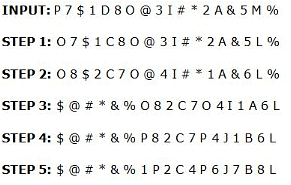
STEP 5 is the last and final step of the rearrangement. As per the rules followed in the above steps, find out the appropriate steps for the following input.
INPUT: N % 6 V 8 * F 3 ^ $ 2 E 5 @ D I # 1
Q. Which of the following element is fifth to the left of the seventh element from the right end in step 3 of the given input?
Study the following information carefully and answer the questions given below.
An alphanumeric symbol arrangement machine, when given an input, rearranges them by following a particular rule in each step. The following is an illustration of input and steps rearrangement.
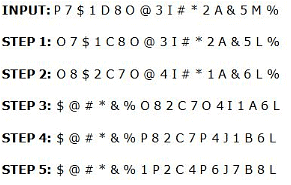
STEP 5 is the last and final step of the rearrangement. As per the rules followed in the above steps, find out the appropriate steps for the following input.
INPUT: N % 6 V 8 * F 3 ^ $ 2 E 5 @ D I # 1
Q. How many letters are there in the English alphabetical series between the elements seventh from both the left and the right ends in step 2 of the given input?
Study the following information carefully and answer the questions given below.
An alphanumeric symbol arrangement machine, when given an input, rearranges them by following a particular rule in each step. The following is an illustration of input and steps rearrangement.
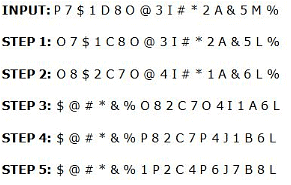
STEP 5 is the last and final step of the rearrangement. As per the rules followed in the above steps, find out the appropriate steps for the following input.
INPUT: N % 6 V 8 * F 3 ^ $ 2 E 5 @ D I # 1
Q. Which of the following element is exactly between the elements fourth from the left end and fifth from the right end in step 4 of the given input?
Study the following information carefully and answer the questions given below.
An alphanumeric symbol arrangement machine, when given an input, rearranges them by following a particular rule in each step. The following is an illustration of input and steps rearrangement.

STEP 5 is the last and final step of the rearrangement. As per the rules followed in the above steps, find out the appropriate steps for the following input.
INPUT: N % 6 V 8 * F 3 ^ $ 2 E 5 @ D I # 1
Q. How many vowels are there in the final step of the given input?
Direction: The words in the question are labelled as A, B, C and D are represented by the group of digit/symbol based on the following coding system. Group (Word – Digit/Symbol) that follows the given conditions mark them as your answers. If none of the four combinations of digit/symbol correctly represent the word, mark (E) i.e. ‘None of the above’ as the answer.
All the vowels in the alphabets are excluded and the rest of the consonants are coded as follows:
B as 1, C as 2, D as 3, up to 5, and then again start with 1, 2, … 5, 1, 2 ... so on up to Z.
Conditions:
I. If the words start with vowel and ends with consonants then code for both is to be¥.
II. If the words start with consonants and ends with vowel then the code for both of them is €.
III. If the word starts and ends with either consonants or vowel (i.e. both should be consonants, or both should be vowels) then both are to be coded as %.
IV. If a vowel comes in between 1st and last word and succeeding consonant after that vowel comes before M then, the vowel is to be coded as & and the consonant is to be coded as +.
V. If a vowel comes in between 1stand last word and the succeeding consonants after that vowel comes after M, then the vowel is to be coded as # and the consonant is to be coded as $.
Q. Which of the following is false?
A. HISTORY = %#$1#$%
B. SUFO= €&+€
C. CART = %#$%
D. MONTH = %#$2%
Direction: The words in the question are labelled as A, B, C and D are represented by the group of digit/symbol based on the following coding system. Group (Word – Digit/Symbol) that follows the given conditions mark them as your answers. If none of the four combinations of digit/symbol correctly represent the word, mark (E) i.e. ‘None of the above’ as the answer.
All the vowels in the alphabets are excluded and the rest of the consonants are coded as follows:
B as 1, C as 2, D as 3, up to 5, and then again start with 1, 2, … 5, 1, 2 ... so on up to Z.
Conditions:
I. If the words start with vowel and ends with consonants then code for both is to be¥.
II. If the words start with consonants and ends with vowel then the code for both of them is €.
III. If the word starts and ends with either consonants or vowel (i.e. both should be consonants, or both should be vowels) then both are to be coded as %.
IV. If a vowel comes in between 1st and last word and succeeding consonant after that vowel comes before M then, the vowel is to be coded as & and the consonant is to be coded as +.
V. If a vowel comes in between 1stand last word and the succeeding consonants after that vowel comes after M, then the vowel is to be coded as # and the consonant is to be coded as $.
Q. Which of the following is true?
A. SPRING = %25&+%
B. KING = %#$%
C. PLANT = %4#+%
D. WASTE = €#$1€
Direction: The words in the question are labelled as A, B, C and D are represented by the group of digit/symbol based on the following coding system. Group (Word – Digit/Symbol) that follows the given conditions mark them as your answers. If none of the four combinations of digit/symbol correctly represent the word, mark (E) i.e. ‘None of the above’ as the answer.
All the vowels in the alphabets are excluded and the rest of the consonants are coded as follows:
B as 1, C as 2, D as 3, up to 5, and then again start with 1, 2, … 5, 1, 2 ... so on up to Z.
Conditions:
I. If the words start with vowel and ends with consonants then code for both is to be¥.
II. If the words start with consonants and ends with vowel then the code for both of them is €.
III. If the word starts and ends with either consonants or vowel (i.e. both should be consonants, or both should be vowels) then both are to be coded as %.
IV. If a vowel comes in between 1st and last word and succeeding consonant after that vowel comes before M then, the vowel is to be coded as & and the consonant is to be coded as +.
V. If a vowel comes in between 1stand last word and the succeeding consonants after that vowel comes after M, then the vowel is to be coded as # and the consonant is to be coded as $.
Q. Which of the following is/are true?
A. LIST = %$+%
B. LIGHT = €1$€
C. STORY = %1#$%
D. JACK = €$4%
Direction: The words in the question are labelled as A, B, C and D are represented by the group of digit/symbol based on the following coding system. Group (Word – Digit/Symbol) that follows the given conditions mark them as your answers. If none of the four combinations of digit/symbol correctly represent the word, mark (E) i.e. ‘None of the above’ as the answer.
All the vowels in the alphabets are excluded and the rest of the consonants are coded as follows:
B as 1, C as 2, D as 3, up to 5, and then again start with 1, 2, … 5, 1, 2 ... so on up to Z.
Conditions:
I. If the words start with vowel and ends with consonants then code for both is to be¥.
II. If the words start with consonants and ends with vowel then the code for both of them is €.
III. If the word starts and ends with either consonants or vowel (i.e. both should be consonants, or both should be vowels) then both are to be coded as %.
IV. If a vowel comes in between 1st and last word and succeeding consonant after that vowel comes before M then, the vowel is to be coded as & and the consonant is to be coded as +.
V. If a vowel comes in between 1stand last word and the succeeding consonants after that vowel comes after M, then the vowel is to be coded as # and the consonant is to be coded as $.
Q. Which of the following is/are false?
A. LADY = %&+%
B. WORK = %#$%
C. WATCH = €#$2€
D. ROCK = %$+%
If all the digits are added within each number, then find the difference between the highest and the lowest number thus formed in each row, then which of the following options yields the resultant as a prime value?
I. 2869, 4638, 1894
II.5293, 4793, 1587
III. 3968, 1793, 5793
In each of the following questions, the relationship between different elements is shown in the statements followed by three conclusions. Find the conclusion which is definitely true.
Q. Statements:
H ≤ J ≤ R = T < G; B ≥ N > G ; H = S ≥ L
Conclusions:
I). T ≤ B
II). L ≤ T
III). S < N
In each of the following questions, the relationship between different elements is shown in the statements followed by three conclusions. Find the conclusion which is definitely true.
Q. Statements:
B < O ≤ I < N = R ; T < Y =R ≤L
Conclusions:
(I) L > A
(II) B ≤ Y
(III) A > R
Direction: Study the following information carefully and answer the questions given below.
A number arrangement machine, when given an input, rearranges it following a particular rule. The following is the illustration of the input and the steps of arrangement.
Input: cool world found house emergency segment repeated
Step 1: repeated cool world found house emergency segment
Step 2: repeated world cool found house emergency segment
Step 3: repeated world found cool house emergency segment
Step 4: repeated world found house cool emergency segment
Step 5: repeated world found house cool segment emergency
Step 6: 4O 1Q 2T 3T 2N 2F 3D
Step 7: K P R Q L D A
Step 8: A D K L P Q R
Step 8 is the last step of the rearrangement.
As per the rules followed in the above steps, find out in each of the following questions.
Input: out special separated constituency follower different rhythm
Q. Which of the following is Step 7 for the given input?
Direction: Study the following information carefully and answer the questions given below.
A number arrangement machine, when given an input, rearranges it following a particular rule. The following is the illustration of the input and the steps of arrangement.
Input: cool world found house emergency segment repeated
Step 1: repeated cool world found house emergency segment
Step 2: repeated world cool found house emergency segment
Step 3: repeated world found cool house emergency segment
Step 4: repeated world found house cool emergency segment
Step 5: repeated world found house cool segment emergency
Step 6: 4O 1Q 2T 3T 2N 2F 3D
Step 7: K P R Q L D A
Step 8: A D K L P Q R
Step 8 is the last step of the rearrangement.
As per the rules followed in the above steps, find out in each of the following questions.
Input: out special separated constituency follower different rhythm
Q. Which of the following is the third element from the right end in step 4?
Direction: Study the following information carefully and answer the questions given below.
A number arrangement machine, when given an input, rearranges it following a particular rule. The following is the illustration of the input and the steps of arrangement.
Input: cool world found house emergency segment repeated
Step 1: repeated cool world found house emergency segment
Step 2: repeated world cool found house emergency segment
Step 3: repeated world found cool house emergency segment
Step 4: repeated world found house cool emergency segment
Step 5: repeated world found house cool segment emergency
Step 6: 4O 1Q 2T 3T 2N 2F 3D
Step 7: K P R Q L D A
Step 8: A D K L P Q R
Step 8 is the last step of the rearrangement.
As per the rules followed in the above steps, find out in each of the following questions.
Input: out special separated constituency follower different rhythm
Q. In step 3, which element is fourth to the right of third element from the left end?
Direction: Study the following information carefully and answer the questions given below.
A number arrangement machine, when given an input, rearranges it following a particular rule. The following is the illustration of the input and the steps of arrangement.
Input: cool world found house emergency segment repeated
Step 1: repeated cool world found house emergency segment
Step 2: repeated world cool found house emergency segment
Step 3: repeated world found cool house emergency segment
Step 4: repeated world found house cool emergency segment
Step 5: repeated world found house cool segment emergency
Step 6: 4O 1Q 2T 3T 2N 2F 3D
Step 7: K P R Q L D A
Step 8: A D K L P Q R
Step 8 is the last step of the rearrangement.
As per the rules followed in the above steps, find out in each of the following questions.
Input: out special separated constituency follower different rhythm
Q. Which of the following element is immediately left of 3K in Step 6?
Directions: Two statements are followed by two Conclusions 1 and 2. You have to consider the statements to be true, even if they seem to be at variance from commonly known facts. You are to decide which of the following conclusions can definitely be drawn from the given statements and indicate your answer accordingly.
Q. Statements:
I: The first rocket which could fly high enough to get into space was the V2 missile which was first launched by Germany in 1942.
II: A rocket engine firing in a launchpad may encounter combustion instabilities and other disturbance that emerges from a launch pad during firing.
Conclusions:
1: Aeronautics is the science or art involved with the study, design, and manufacturing of air flight capable machines, and the techniques of operating aircraft and rockets within the atmosphere.
2: Working on rocket launching projects involves risks.



